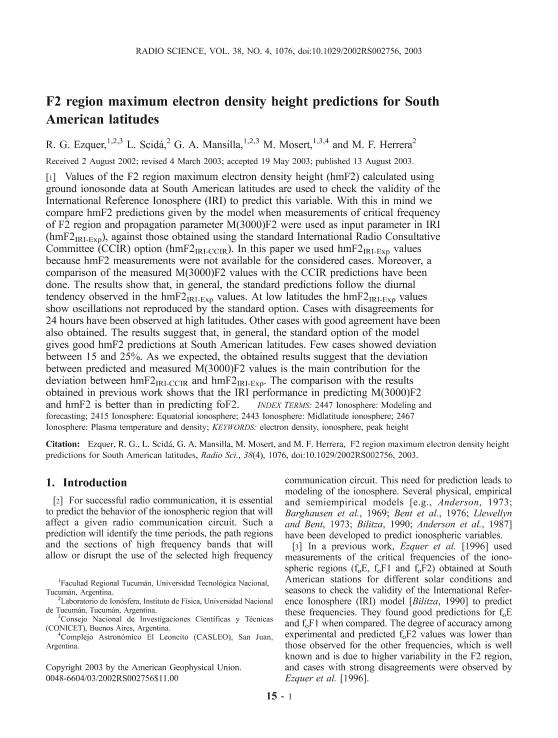Mostrar el registro sencillo del ítem
dc.contributor.author
Ezquer, Rodolfo Gerardo

dc.contributor.author
Scidá, Luis
dc.contributor.author
Mansilla, Gustavo Adolfo

dc.contributor.author
Mosert, Marta Estela

dc.contributor.author
Herrera, Marcelo F.
dc.date.available
2020-03-27T22:04:54Z
dc.date.issued
2003-12
dc.identifier.citation
Ezquer, Rodolfo Gerardo; Scidá, Luis; Mansilla, Gustavo Adolfo; Mosert, Marta Estela; Herrera, Marcelo F.; F2 region maximum electron density height predictions for South American latitudes; American Geophysical Union; Radio Science; 38; 4; 12-2003; 1-11
dc.identifier.issn
0048-6604
dc.identifier.uri
http://hdl.handle.net/11336/101200
dc.description.abstract
Values of the F2 region maximum electron density height (hmF2) calculated using ground ionosonde data at South American latitudes are used to check the validity of the International Reference Ionosphere (IRI) to predict this variable. With this in mind we compare hmF2 predictions given by the model when measurements of critical frequency of F2 region and propagation parameter M(3000)F2 were used as input parameter in IRI (hmF2IRI-Exp), against those obtained using the standard International Radio Consultative Committee (CCIR) option (hmF2IRI-CCIR)- In this paper we used hmF2 IRI-Exp values because hmF2 measurements were not available for the considered cases. Moreover, a comparison of the measured M(3000)F2 values with the CCIR predictions have been done. The results show that, in general, the standard predictions follow the diurnal tendency observed in the hmF2 IRI-Exp values. At low latitudes the hmF2IRI-Exp values show oscillations not reproduced by the standard option. Cases with disagreements for 24 hours have been observed at high latitudes. Other cases with good agreement have been also obtained. The results suggest that, in general, the standard option of the model gives good hmF2 predictions at South American latitudes. Few cases showed deviation between 15 and 25%. As we expected, the obtained results suggest that the deviation between predicted and measured M(3000)F2 values is the main contribution for the deviation between hmF2IRI-CCIR and hmF2IRI-Exp. The comparison with the results obtained in previous work shows that the IRI performance in predicting M(3000)F2 and hmF2 is better than in predicting foF2.
dc.format
application/pdf
dc.language.iso
eng
dc.publisher
American Geophysical Union

dc.rights
info:eu-repo/semantics/openAccess
dc.rights.uri
https://creativecommons.org/licenses/by-nc-sa/2.5/ar/
dc.subject
ELECTRON DENSITY
dc.subject
IONOSPHERE
dc.subject
PEAK HEIGHT
dc.subject.classification
Geoquímica y Geofísica

dc.subject.classification
Ciencias de la Tierra y relacionadas con el Medio Ambiente

dc.subject.classification
CIENCIAS NATURALES Y EXACTAS

dc.title
F2 region maximum electron density height predictions for South American latitudes
dc.type
info:eu-repo/semantics/article
dc.type
info:ar-repo/semantics/artículo
dc.type
info:eu-repo/semantics/publishedVersion
dc.date.updated
2020-03-25T14:39:39Z
dc.journal.volume
38
dc.journal.number
4
dc.journal.pagination
1-11
dc.journal.pais
Estados Unidos

dc.journal.ciudad
Washington
dc.description.fil
Fil: Ezquer, Rodolfo Gerardo. Universidad Nacional de Tucumán. Facultad de Ciencias Exactas y Tecnología. Departamento de Física. Laboratorio de Ionósfera; Argentina. Consejo Nacional de Investigaciones Científicas y Técnicas. Centro Científico Tecnológico Conicet - Tucumán; Argentina
dc.description.fil
Fil: Scidá, Luis. Universidad Nacional de Tucumán. Facultad de Ciencias Exactas y Tecnología. Departamento de Física. Laboratorio de Ionósfera; Argentina
dc.description.fil
Fil: Mansilla, Gustavo Adolfo. Universidad Nacional de Tucumán. Facultad de Ciencias Exactas y Tecnología. Departamento de Física. Laboratorio de Ionósfera; Argentina. Consejo Nacional de Investigaciones Científicas y Técnicas. Centro Científico Tecnológico Conicet - Tucumán; Argentina
dc.description.fil
Fil: Mosert, Marta Estela. Consejo Nacional de Investigaciones Científicas y Técnicas. Centro Científico Tecnológico Conicet - San Juan. Instituto de Ciencias Astronómicas, de la Tierra y del Espacio. Universidad Nacional de San Juan. Instituto de Ciencias Astronómicas, de la Tierra y del Espacio; Argentina
dc.description.fil
Fil: Herrera, Marcelo F.. Universidad Nacional de Tucumán. Facultad de Ciencias Exactas y Tecnología. Departamento de Física. Laboratorio de Ionósfera; Argentina
dc.journal.title
Radio Science

dc.relation.alternativeid
info:eu-repo/semantics/altIdentifier/doi/https://dx.doi.org/10.1029/2002RS002756
dc.relation.alternativeid
info:eu-repo/semantics/altIdentifier/url/https://agupubs.onlinelibrary.wiley.com/doi/full/10.1029/2002RS002756
Archivos asociados
